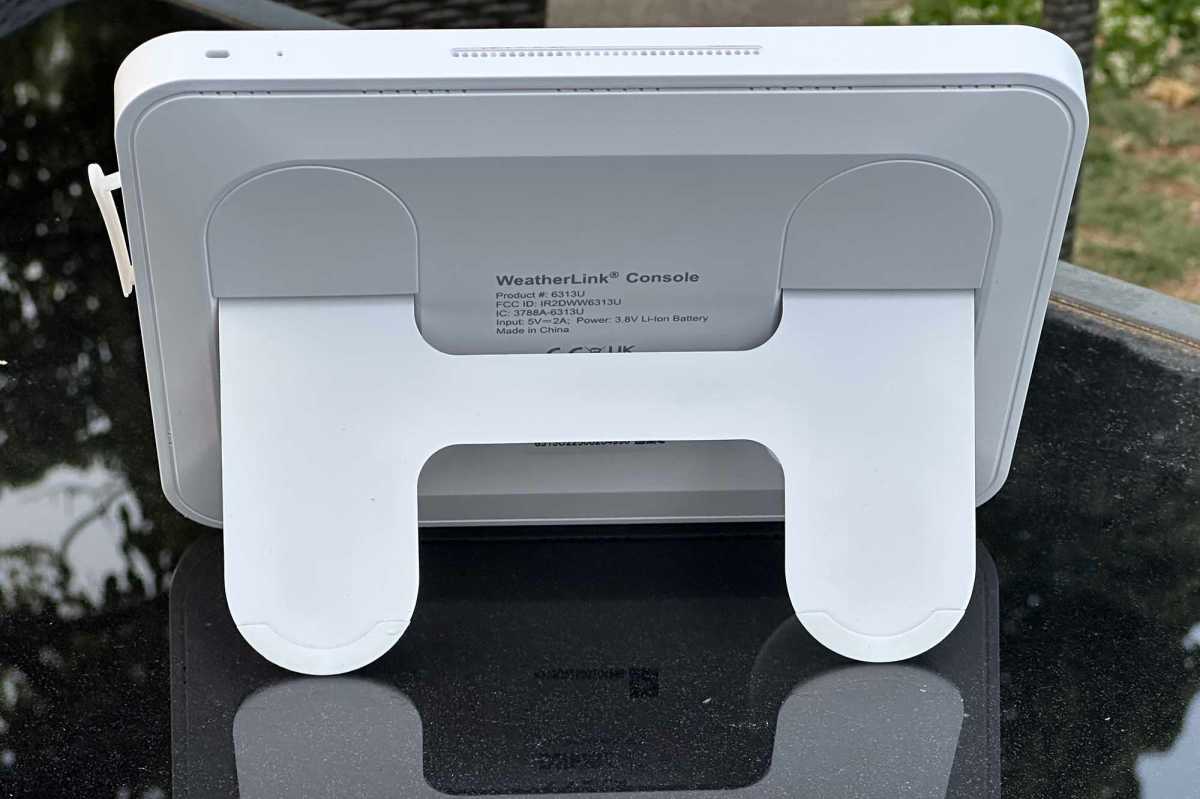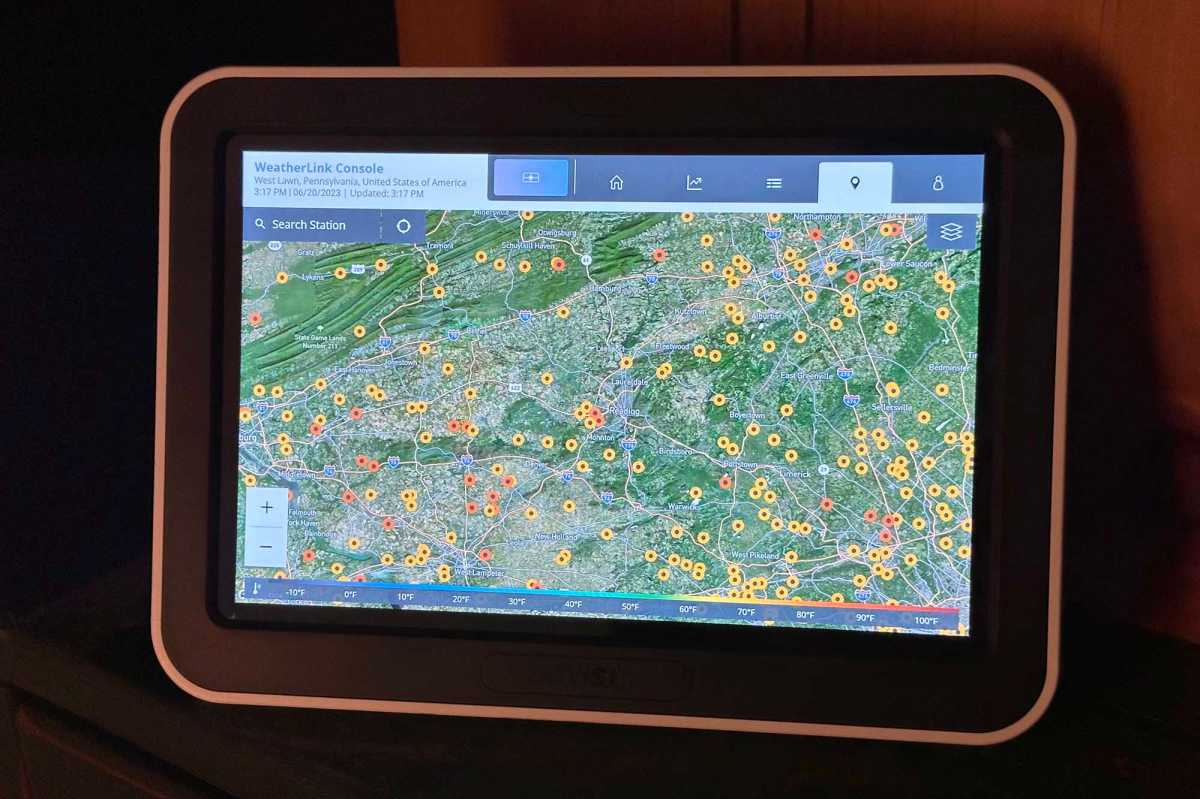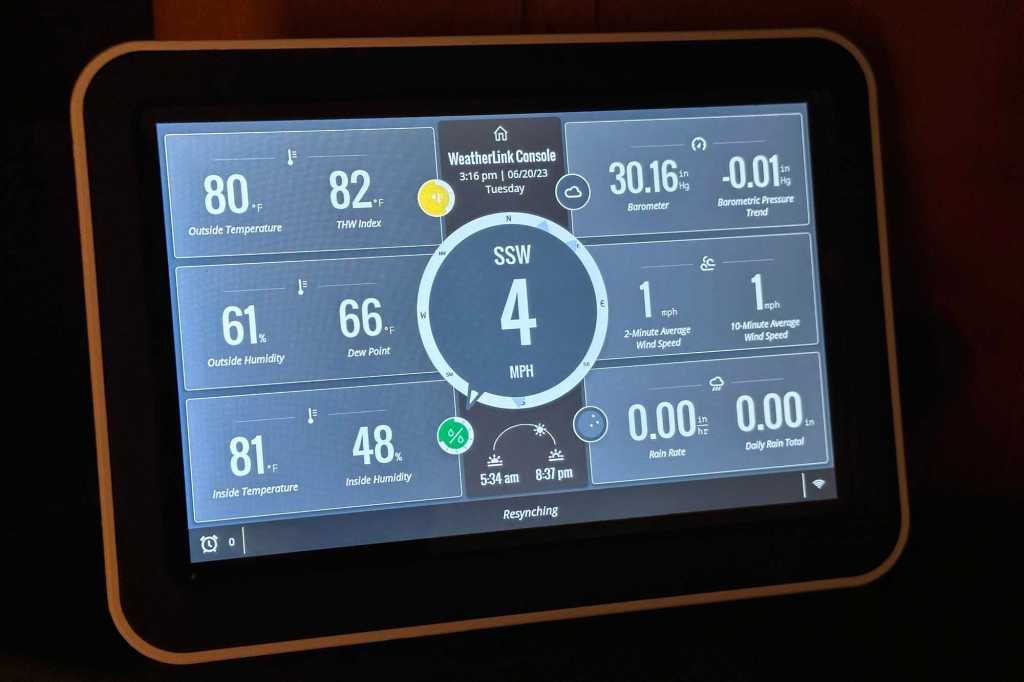Expert’s Rating
Pros
- The brightest and best-looking console on the market
- Lots of functionality
- Expandable? Time will tell
Cons
- Its best features are buried
- Confusing to set up
- High price tag
Our Verdict
With this console, using a Davis weather station finally feels like you’re in the 21st Century. Just be prepared to uncover its best features, which are buried in its user interface.
Price When Reviewed
$395.00
Best Prices Today: Davis WeatherLink Console
$395.00
Davis Instruments
$395.00
The Davis WeatherLink Console is the company’s most significant new product in nearly two decades, apart from Davis’ Wi-Fi-linked, but display-less WeatherLink Live. This new console will change how you interact with your Davis weather-tracking gear.
A bright color touchscreen displays all your weather information. You can also customize what you see. With the console tied into the web-based WeatherLink service, you can access charting and historical capabilities, including setting more than 100 event alarms.
The WeatherLink Console is a good product that gets me excited about using Davis weather-tracking systems again.
Now for the bad news: The WeatherLink Console costs $395. That makes it more expensive than many of the entire weather stations we’ve reviewed. Some long-time Davis customers have grumbled about the price, pointing to regulatory filings that reveal there isn’t much in terms of sophisticated hardware inside the console. But the WeatherLink Console doesn’t look cheap, and it is a step up from what you get from the competition.
From my hands-on experience, I can say that the WeatherLink Console is a good product that gets me excited about using Davis weather-tracking systems again. That said, Davis needs to do a lot of work to make this a truly great console.
This review is part of TechHive’s in-depth coverage of the best home weather stations.
Setting up the Davis WeatherLink Console
Davis supplies everything you need—apart from the tools—to set up the console, whether you’ll be using it on a flat surface or mounting it to the wall. The instructions that come in the box, however, aren’t as thorough as would have liked. I recommend downloading the digital version of the WeatherLink Console user manual, as it provides more details.

The Davis WeatherLink Console can be operated on a tabletop or mounted to the wall. Everything you need is included in the box.
Ed Oswald/Foundry
Like other modern Davis products, the console uses a USB cord for power. If you’re short on outlets, using a 2-amp or higher USB port on a computer works. There is no need to change batteries: the console has a rechargeable power supply capable of powering it for up to a day, according to Davis.
You’ll need to know your Davis Station ID before installation. Unless you’ve changed this setting or have additional weather-station sensors, it will be ID1. The console also asks some questions about how you want to set it up: as an upgrade to an Davis old console or as an entirely new one. I was unsure what to choose out of fear I would delete my historical data, so I set it up as a new console.
Going by the wording of the setup instructions, upgrading from an existing console will not bring your data over from the old device; that data will be deleted. I have amassed a vast amount of weather data over the years, so that would have been a catastrophic loss for me.
The setup process is a bit cumbersome and confusing, especially as is relates to incorporating some other Davis devices. I couldn’t get the console to display information from my Davis AirLink air quality monitor, for example, and I learned later that the two device don’t work together—at least not yet.
Using the Davis WeatherLink Console
Android users will find the Davis WeatherLink Console’s user interface to be at least somewhat familiar, since the device runs on that operating system. The display is very bright and readable from across the room. It adjusts based on ambient light and goes to sleep when it’s not in active use.

They’re not discussed in the user manual, but I’m assuming these ports are for future expandability or to take advantage of new features.
Ed Oswald/Foundry
If you have multiple weather sensors, swiping across the console displays each one. I assume this is how you’d access your AirLink readings once that functionality arrives. A high-contrast mode removes the blue colors for those with color blindness, and I preferred using it in darker rooms. The product shots I’ve seen make the display look cluttered, but I didn’t find that to be an issue in real-world usage. You can configure the console to display your weather data in six panels, as shown in the photo on this page, or in four panels.
You might think tapping a particular reading—outdoor temperature, for example—would switch to a display of historical data. It doesn’t do anything; if you want that, you must tap the home icon. When you do, you’ll see tabs for the “bulletin” (Davis’ standard table-based text view of all your current weather data), graphs, historical data, a map showing conditions at nearby Davis weather stations, and your own settings.
The color-coded dots Davis uses to report temperature and air quality readings work just fine on its online maps, but they just look like so much clutter on the WeatherLink Console’s smaller display. I’d prefer to see the actual number than tap on the dot. In fact, the user interface relies far too much on tapping to display detailed information.

The dots on this map represent readings from other Davis weather stations that are reported to the WeatherLink service.
Ed Oswald/Foundry
Simplifying things and getting people to what they’re looking for faster would significantly improve the user experience. The problem isn’t with how the UI looks but how it works.
I also had an issue where the status bar kept displaying a “resynching” message, even though the currently displayed information appeared to be up to date. Davis’ user manual instructions didn’t provide any answers, so I reached out to tech support, who informed the problem is related to the console not having a good connection to the connected sensor suite. So, I tried moving the console to several different locations—including outdoors, right next to the sensor suite—but the message continued to appear. Perhaps it’s a software bug that will be squished eventually.
The Davis ‘data silo’ strikes again
My biggest criticism of the Davis WeatherLink Console is that it creates yet another data silo. It’s a problem Davis has had since it first moved to a cloud-based data platform. I can’t merge the weather data I’ve accumulated from my Davis WeatherLink Live, and that data is separate from—and equally unmergeable with—my WeatherLink IP data.
The bottom line is that you can’t truly retire old Davis equipment after you upgrade. I’m still running my WeatherLink IP dongle because it has all my historical data back to 2016. I should no longer need the WeatherLink Live either, but without that, I can’t connect my Davis air quality sensor, which has also been tracking weather data (more frequently and with more detail than the Weatherlink IP) since it was installed.
I shouldn’t have to resort to tracking everything in an Excel spreadsheet, but that’s my only means of maintaining a historical record. Any long-term Davis customer will encounter the same problems. The WeatherLink Console should be the perfect opportunity for Davis to pull all this data together. Trust me, you don’t want to fight with Excel to do this. Besides, all your data is already on Davis’ servers—they need to figure it out.
The WeatherLink Console is a good start that could have been great
The WeatherLink Console is Davis Instruments’ first foray into modern weather stations, and it’s a good overall start. The hardware is solid, as I’ve come to expect from Davis Instruments, and its biggest shortcomings should be fixable with software and firmware updates. But that just emphasizes the fact that we shouldn’t have to put up with such annoyances from a $395 console.
If you already own Davis’ WeatherLink Live, the WeatherLink Console doesn’t do much more than add a display, but it frees you from needing to pull out your phone when you want a detailed weather report. And while there is a lot to be said for having that information displayed on the wall, desktop, or table, Davis needs to make better use of that touchscreen. As for its high price tag, there will be opportunities to pick it up on sale as Davis dealers compete for your business.

